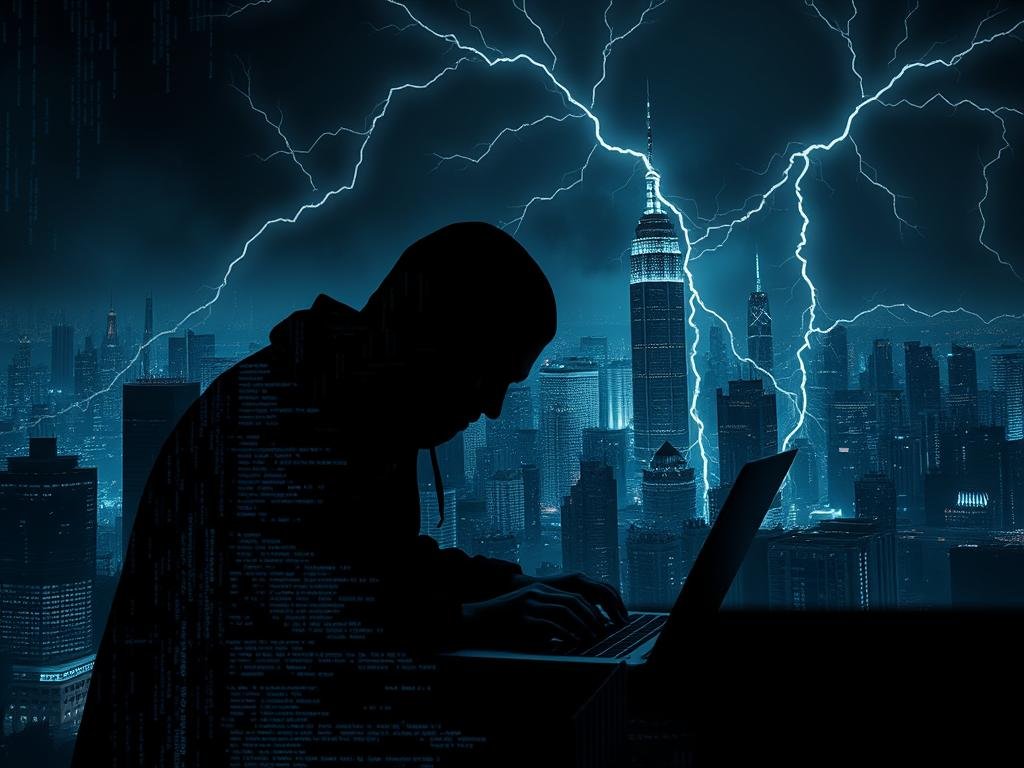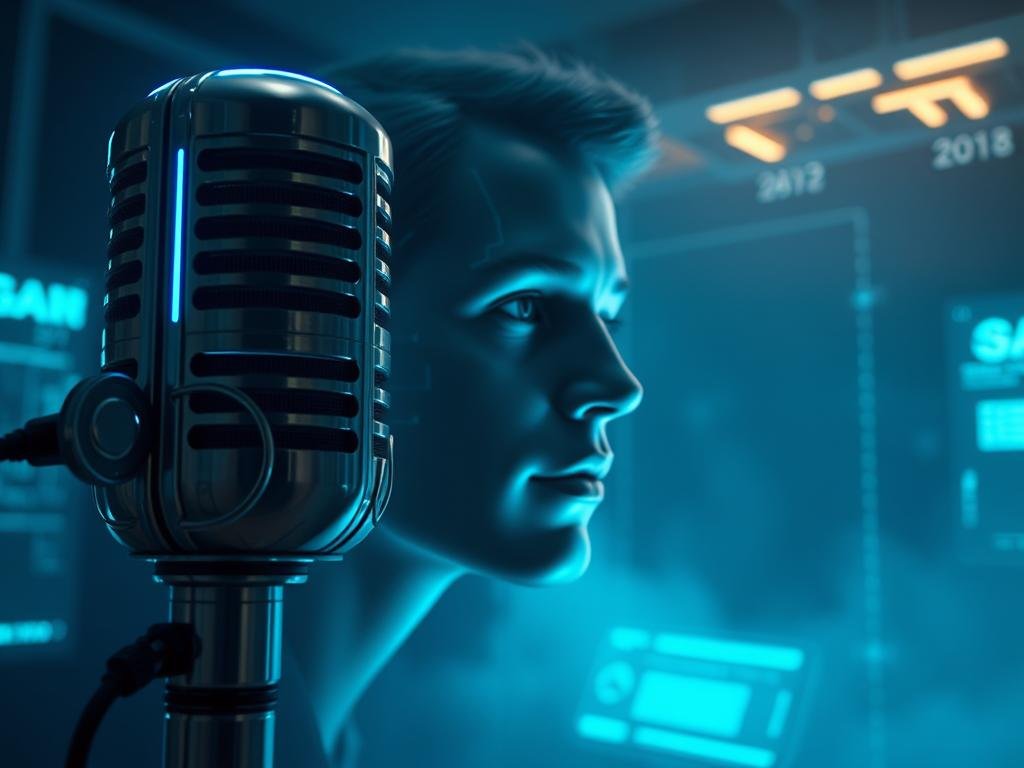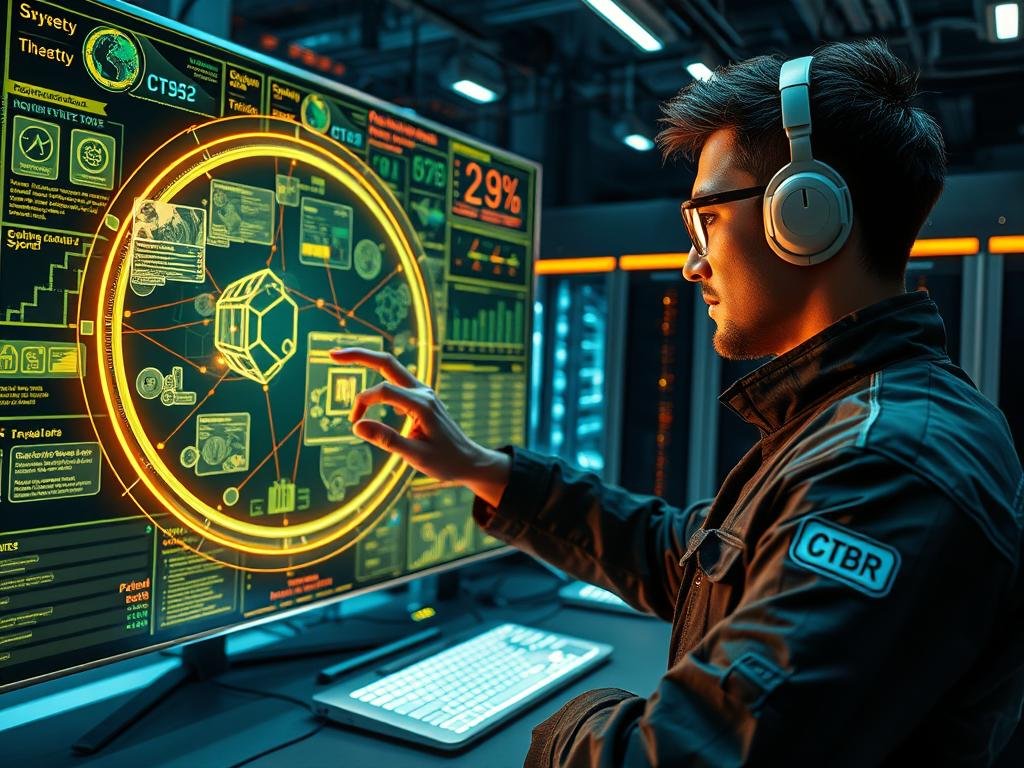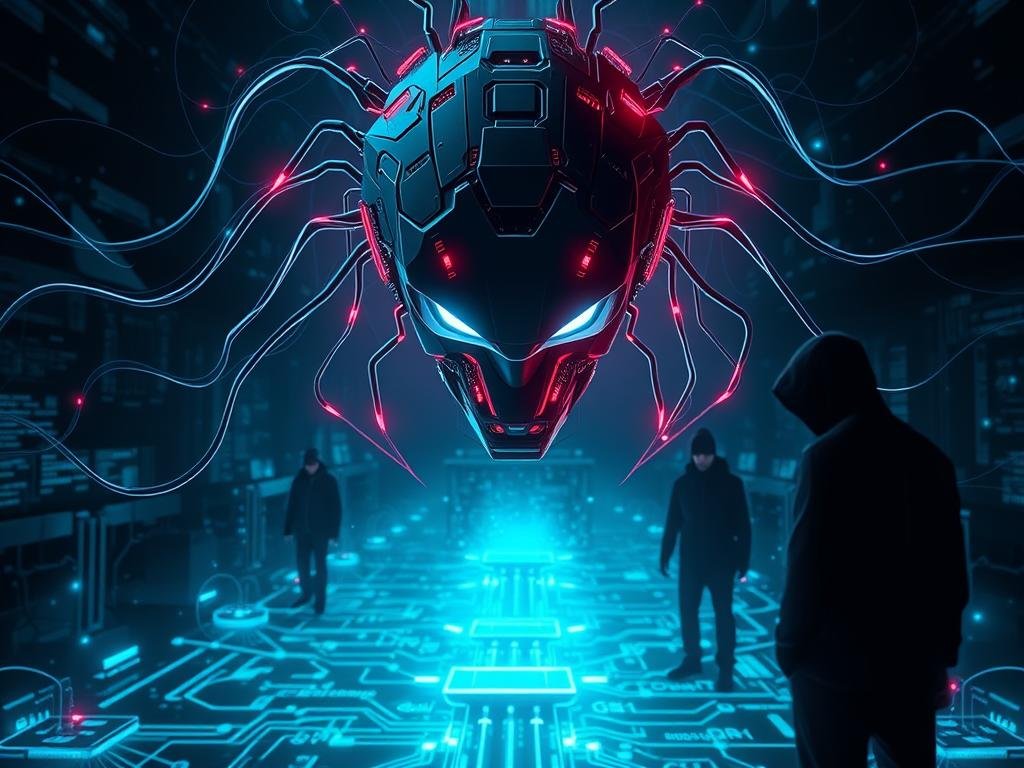A staggering 91% of all cyberattacks start with phishing emails. This makes it a big threat to both people and businesses. As technology gets better, bad guys use artificial intelligence to make their attacks smarter. This makes them harder to spot.
You should know about these new dangers and take steps to protect yourself. Experts say AI-assisted cyberattacks can cause big problems, like stealing data and money.
Key Takeaways
- Understand the growing threat of AI-powered cyberattacks.
- Learn how to identify and avoid phishing emails.
- Take necessary precautions to protect your personal and business data.
- Stay informed about the latest cybersecurity trends and AI-related threats.
- Report suspicious emails to the relevant authorities.
The Evolving Landscape of Cybersecurity Threats
AI technology is changing the cybersecurity threat scene. Now, you face threats that are smarter and harder to spot.
How AI Has Transformed the Threat Landscape
AI has changed the game in cybersecurity threats. AI-generated phishing emails are getting better, with 60% of recipients falling for them. This shows we need better security than before.
AI in cyberattacks has led to:
- More advanced phishing campaigns using natural language processing
- Deepfake scams that trick even the most careful people
- Autonomous malware that can change and grow
Why Traditional Security Measures Are Becoming Obsolete
Old security tools like firewalls and antivirus software can’t keep up with AI threats. We need new, smarter security solutions.
Traditional measures are failing for several reasons:
- They can’t spot AI-made phishing emails and deepfake scams
- They lack the ability to analyze threats in real-time
- They can’t handle the scale and complexity of AI attacks
To keep up, we must use AI-powered security solutions. These can detect and act on threats as they happen.
Understanding AI-Powered Threat Actors
AI has given threat actors advanced tools. The world of cybersecurity is changing fast. Now, AI-powered hacking is a big worry. As threat actors use AI more, cyber threats are getting more complex.

From Solo Hackers to Nation-State Actors
AI threat actors range from solo hackers to nation-states. Each group has its own goals and skills. This makes the threat world more complicated.
- Solo hackers use AI to improve their skills and earn money.
- Organized crime groups use AI for big cybercrime plans.
- Nation-state actors use AI for spying and to harm critical systems.
Because of this variety, everyone needs to be ready for many kinds of attacks.
The Democratization of Advanced Hacking Tools
AI hacking tools are now easier to get. This means more people can launch smart attacks, no matter their skill level. More threat actors are using AI tools.
| Threat Actor | Motivation | Typical AI Tools Used |
|---|---|---|
| Solo Hackers | Financial gain, notoriety | AI-powered phishing tools, automated vulnerability scanners |
| Organized Crime Groups | Financial gain, data theft | AI-driven malware, deepfake technology |
| Nation-State Actors | Espionage, disruption of critical infrastructure | Advanced persistent threat (APT) tools, AI-powered intrusion detection evasion |
As cybersecurity evolves in 2025, knowing these threats and tools is key. It helps in making strong defense plans.
5 Most Dangerous AI Cyberattacks You Should Know About
AI-powered cyberattacks are a growing concern for everyone. As AI gets smarter, hackers use it to launch complex attacks. These attacks can slip past old security systems.
Advanced Phishing Campaigns Using Natural Language Processing
AI-powered phishing emails are getting very good at tricking people. They use natural language processing (NLP) to sound like real emails. These emails can target specific people, making them very effective. To protect against AI attacks, be careful with emails that ask for personal info.
Deepfake Social Engineering Scams
Deepfakes are AI-made audio or video that can trick people. They are used in scams to get sensitive info or make people do things they shouldn’t. It’s important to check if any request is real.

Autonomous Malware and Self-Modifying Code
AI malware can change and adapt, making it hard to catch. It uses self-modifying code to avoid detection. This can cause big data breaches and financial losses.
AI-Driven Password Cracking and Authentication Bypass
AI can guess passwords faster than before. It uses brute force or patterns to crack them. AI can also get past security checks by acting like a real user. This can lead to AI-driven data breaches, putting sensitive info at risk.
| Cyberattack Type | Description | Impact |
|---|---|---|
| Advanced Phishing | Uses NLP to craft convincing emails | Data theft, financial loss |
| Deepfake Scams | AI-generated audio/video for social engineering | Financial loss, reputational damage |
| Autonomous Malware | Evolves and adapts to evade detection | Data breaches, financial losses |
| AI-Driven Password Cracking | Uses AI to guess or crack passwords | Unauthorized access, data breaches |
To stay safe, know about these threats and act early. For more info on AI cyberattacks, check out CrowdStrike’s guide and Digital Vista’s article on AI in apps and machine learning.
Real-World Examples of AI-Powered Hacking
AI-powered hacking is a real threat now, affecting businesses and people everywhere. These attacks are getting smarter, so our defenses must keep up. Let’s look at some examples that show how dangerous AI hacking can be.
Case Study: Voice Cloning for Executive Fraud
Cybercriminals used AI to make a fake CEO voice. They tricked an employee into moving money to a wrong account. This shows how AI can fake voices to commit fraud, getting past old security checks.

Case Study: AI-Generated Phishing That Bypassed Detection
AI made phishing emails that fooled security systems. These emails were very real and personal. They showed how AI can make fake emails that are hard to spot.
Case Study: Autonomous Attack Systems in Action
AI-powered hacking now includes self-changing attacks. These attacks can change and grow on their own. A case showed how a self-changing malware got past strong defenses.
These stories show we need better ways to protect ourselves from AI hacking. As AI gets better, we must stay ahead in defending ourselves.
How to Recognize AI-Powered Threats in Your Daily Life
AI-driven attacks are on the rise, and knowing how to spot them is key to staying safe online. As AI becomes more common in our lives, so do the chances of cyberattacks. It’s important to know the signs.

Warning Signs of Deepfake Content
Deepfakes are AI-made audio or video that can look real. Watch out for content that seems too perfect or off. For example, a deepfake video of someone famous could spread false information or sway opinions.
Look for uneven lighting or shadows, bad lip-syncing, or odd body language. If you see these, it’s best to doubt the content’s authenticity.
Red Flags in AI-Generated Communications
AI can make emails or messages that seem real. Be wary of messages with odd language or a too formal tone. This could mean it’s AI-made.
Also, watch for content that’s too generic or doesn’t make sense. Real messages usually address you by name and are about something you care about. AI messages might not have this personal touch.
Behavioral Patterns of AI-Driven Malware
AI malware can act strangely. Keep an eye on your devices for odd behavior, like sudden crashes or weird network actions.
Some malware changes and grows thanks to AI, making it tough to catch. Always update your antivirus and operating system to fight off new threats.
“The best way to fight AI threats is to know what to look for,” says cybersecurity expert, John Smith. “By staying informed and taking steps to protect yourself, you can lower your risk of falling prey to these dangers.”
Essential Protection Strategies for Individuals
In today’s world, keeping your personal data safe is key. With AI attacks getting smarter, it’s important to be careful and proactive about your online safety.
Multi-Factor Authentication in the Age of AI
Using multi-factor authentication (MFA) is a great way to protect against AI attacks. MFA adds an extra layer of security to your online accounts. This makes it much harder for hackers to get in, even if they guess your password.
Digital Literacy and Healthy Skepticism as Defense Tools
Being smart about the internet and being cautious are important. Stay up-to-date with the latest online safety tips. Be careful with emails, messages, and calls you don’t know. This way, you can avoid falling for AI tricks.
Personal Data Protection Best Practices
Keeping your personal info safe is a must in the AI era. Be careful about what you share online. Use strong, unique passwords and keep your software up-to-date. These steps help protect you from AI threats.
Consumer-Grade AI Detection Tools Worth Trying
There are tools out there that can help spot AI threats. These tools can find fake emails and other dangers. They’re not perfect, but they’re a good tool to have in your fight against AI attacks.
By using MFA, staying smart online, protecting your data, and trying AI detection tools, you can boost your online safety. This is important as AI threats grow more common.
Robust Defense Frameworks for Businesses
To fight AI-powered cyberattacks, businesses need strong defense plans. As AI threats grow, companies must keep up. They should use the latest tech and best practices in their defense.
Implementing AI-Powered Security Solutions
AI security tools are key to a strong defense. They look at lots of data to find threats. This helps businesses spot dangers early and act fast.
AI tools can also predict and stop autonomous attack strategies. They find weak spots and suggest fixes.
Employee Training for the New Threat Landscape
Technology is important, but training employees is just as vital. As threats get smarter, workers need to know how to spot them. Training should teach about new AI-driven attack vectors and how to spot them.
Zero-Trust Architecture and Continuous Verification
Zero-trust architecture is also key. It checks who and what gets to sensitive data all the time. This makes it harder for AI attacks to succeed.
For more on cybersecurity, check out 7 Cybersecurity Frameworks to Reduce Cyber.
Incident Response Planning for AI-Driven Attacks
Even with strong defenses, breaches can happen. So, having a good plan for when they do is essential. This plan should cover AI attacks, how to respond, and practice drills.
| Defense Strategy | Description | Benefits |
|---|---|---|
| AI-Powered Security Solutions | Utilize AI to analyze data and detect threats | Enhanced threat detection, faster response times |
| Employee Training | Educate employees on recognizing AI-powered threats | Reduced risk of human error, improved incident response |
| Zero-Trust Architecture | Implement continuous verification of user identities and devices | Strict access control, reduced breach risk |
| Incident Response Planning | Develop and regularly test response plans for AI-driven attacks | Improved readiness, minimized breach impact |
The Future of Cybersecurity: AI Offense vs. Defense
The future of cybersecurity is being shaped by the battle between AI offense and defense. AI technologies are advancing, making both sides use machine learning to get better.
Attackers are using AI to create more complex threats. Defenders are using AI to improve their detection and response. This cat-and-mouse game is driving innovation on both sides.
Emerging AI Attack Methodologies on the Horizon
We can expect new attack methodologies as AI grows. Some possible threats include:
- AI-generated deepfakes that can fool even the most careful people
- Autonomous malware that can change and grow in real-time
- Advanced phishing campaigns that use natural language processing to seem real
These new threats will test traditional cybersecurity measures. Defenders must stay alert and adjust their strategies.
How Defensive AI Is Evolving to Counter Threats
Defensive AI is getting more advanced to keep up with threats. It’s evolving in several ways:
- Improved anomaly detection using machine learning algorithms
- Enhanced predictive analytics to predict threats
- Automated response systems that can act fast
By using these advanced technologies, organizations can boost their cybersecurity. They can stay ahead of new threats.
The growth of AI-powered cybersecurity solutions is key to fighting off sophisticated threats. As the cybersecurity world keeps changing, AI will be vital in both the threats and defenses we use.
Conclusion: Staying Vigilant in an AI-Powered Threat Landscape
AI is changing how we see cybersecurity. It’s more important than ever to stay alert. Keep up with new digital threats and smart technology breaches to protect yourself and your group.
To stay safe online, use strong defense plans. This includes multi-factor authentication, learning about digital safety, and protecting your personal data. Be careful of ai-powered attacks, like advanced phishing or deepfake scams.
Know the threats and use good security steps to lower your risk. Stay updated, stay alert, and stay one step ahead of threats. This way, you can keep your online space safe.
FAQ
What are AI-powered cyberattacks, and how do they differ from traditional cyberattacks?
AI-powered cyberattacks use artificial intelligence and machine learning. They launch sophisticated attacks that traditional security can’t stop. These attacks are hard to detect and can cause a lot of damage.
How has AI transformed the cybersecurity threat landscape?
AI has changed the threat landscape by letting attackers use more advanced tactics. Now, we see AI-generated phishing emails and deepfake scams. It’s getting harder for people and businesses to spot and stop these attacks.
What are some of the most dangerous AI cyberattacks that individuals and businesses should be aware of?
Some dangerous AI attacks include advanced phishing, deepfake scams, and autonomous malware. AI is also used for password cracking and getting past security checks.
How can individuals protect themselves against AI-powered threats?
To protect yourself, use multi-factor authentication and stay digitally savvy. Be careful with links and personal info online. These steps can help keep you safe.
What are some robust defense frameworks that businesses can implement to protect against AI-powered threats?
Businesses can use AI for security, train employees, and adopt zero-trust architecture. They should also plan for AI-driven attacks. These steps can help defend against AI threats.
How is defensive AI evolving to counter emerging AI attack methodologies?
Defensive AI is getting better at fighting AI attacks. It uses advanced AI solutions to detect and stop AI attacks. This creates a constant battle between AI offense and defense.
What is the role of machine learning in cybersecurity, and how can it be used to protect against AI-powered threats?
Machine learning is key in cybersecurity. It helps create AI security solutions that can fight AI attacks. It analyzes data to find threats before they happen.
How can individuals and businesses stay ahead of the evolving threat landscape and protect against AI-powered threats?
To stay safe, stay updated on AI threats and use strong defense strategies. Keep your security up to date. This way, you can protect against AI attacks.
